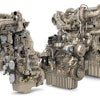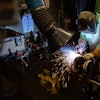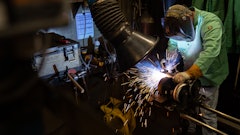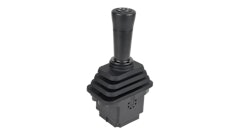It is virtually impossible to overstate the importance of an engine's cooling system because it directly affects how reliable and durable the machine will be in the field. OEM engineers must work closely with their engine manufacturer and/or distributor on the design and selection of an engine's cooling system.
It's important for equipment engineers to understand the key components of the cooling system because of their effect on the equipment's overall performance.
The main job of the cooling system is to reduce engine temperature. The cooling system removes heat from the engine by transferring it from the engine to the coolant. Once coolant is moved to the radiator, the air temperature increases, decreasing the coolant temperature by 5 to 10 F. This process repeats itself, circulating coolant throughout the engine.
The core components of the cooling system include the radiator, the fan and its shrouding, coolant lines, coolant pump, thermostat, coolant jackets, and the charge air cooler. Some engines also utilize an exhaust gas recirculation (EGR) cooler. Most engine manufacturers don't supply components that are external to the engine, such as the radiator, directly from the factory. OEMs will typically need to work with their engine distributor or another resource to complete the cooling system.
Experts at John Deere Power Systems offer the following advice to help OEMs ensure that an application's engine and cooling system work together to keep the equipment running smoothly.
Aftercooling
An engine's aspiration can involve the cooling system and directly affects the equipment's performance.
Diesel engines can have four kinds of aspiration: natural aspiration, turbocharging, liquid-to-air aftercooling and air-to-air aftercooling. Liquid-to-air aftercooling and air-to-air aftercooling affect the engine's cooling system. Air-to-air aftercoolers and engine radiators require a fine balance between the systems to maintain optimum charge-air temperatures and coolant temperatures across the engine's operating range.
Air-to-air and liquid-to-air aftercooled engines have a higher power density than engines that are only turbocharged or naturally aspirated. The more power density an engine has, the more horsepower it generates in a smaller displacement. When the air going into the engine cylinders is cooled, engineers can calibrate higher power ratings, thus increasing power density. Liquid-to-air aftercooled engines use coolant, which runs at about 180 F, to lower the temperature of the air coming out of the turbo (about 200 to 300 F) before it's routed back to the cylinders. The most power-dense form of aspiration is air-to-air aftercooling, which uses ambient air to lower the temperature of the air from the turbo.
The aftercooler and the cooling fan are not only crucial to performance but are also key to emissions compliance. The performance of the aftercooler affects the temperature of the combustion in the cylinder and lowers the amount of NOx produced.
Coolant
Engines must be shipped without coolant, so OEM customers are responsible for filling and maintaining the engine's cooling systems. Almost all diesel engines use glycol-based heavy-duty coolant, although a few engine manufacturers make oil-cooled engines. Knowing the best coolant solution for an engine is vital to preventing cylinder liner erosion, pitting and corrosion damage to aluminum engine components.
Heavy-duty diesel engine coolant should be comprised of deionized or distilled water and ethylene glycol or propylene glycol. Ethylene glycol concentrate must be low-silicate and meet ASTM D4985. High-silicate ethylene glycol is for use in automotive applications and should not be used in diesel engines.
Propylene glycol must also be low-silicate. The chemical properties of propylene glycol and ethylene glycol are different, and they should not be mixed. The system must be flushed before changing mixtures.
In heavy-duty industrial applications, water should not be substituted for coolant. Water will allow corrosion to occur, and it also allows cavitation, which causes holes to form in the cylinder liners and leaves a path for the coolant to enter the combustion chamber and power cylinder. The right coolant mixture will help ensure long cylinder life.
Operators need to monitor coolant at the intervals prescribed in the operator's manual. Coolant analysis, such as John Deere COOLSCAN, determines whether the coolant needs supplemental coolant additive (SCA) or needs to be flushed and replaced. SCA is a nitrite-based chemical additive used to protect against cylinder liner erosion and pitting.
One of the important functions of the cooling system is to keep oil at a low temperature. The lubrication property of engine oil begins to break down at approximately 240 F. Bearings, liners, valves and other engine components all depend on proper lubrication. Electronically controlled John Deere engines monitor coolant temperature and charge-air temperature, which are indicators of oil temperature. As a safeguard, these engines automatically derate themselves if they get too hot.
Radiators
The function of the radiator is to transfer engine heat from the coolant to the ambient air, cooling the engine. When designing a system that puts a conventional radiator in an engine compartment, OEMs must consider air movement. The fan has to draw in cooler air from outside, move it through the radiator, and exhaust the hot air in such a way that it can not be drawn back into the radiator.
Radiators are typically not part of the factory engine package and need to be installed carefully by an engine distributor or by the OEM. A properly installed radiator pumps cool air in and hot air out of the engine compartment and does not allow the hot air to recirculate. In off-highway applications, radiators should be sized and installed so that they do not depend on outside air movement to help cool the engine.
The two preferred ways to install a radiator in an off-highway application are ducting the front of the radiator to the outside or relocating the engine package so that the radiator is flush with the cool air source. In each case, the hot air should escape through the opposite side, eliminating hot air recirculation.
In addition to the heat dissipated through the radiator system, a considerable amount of heat is radiated from the engine surfaces to the atmosphere or interior of the engine compartment. Engine compartment ventilation needs to be adequate to control the air temperature under the hood.
Every cooling system must separate air from the coolant so that air is not drawn back into the radiator and engine. This is called deaeration and is essential to engine performance. OEMs should make sure that the radiator they choose has adequate deaeration capabilities.
The most effective type of deaeration system uses an auxiliary tank and a bypass flow for continuous deaeration. In some applications, a top tank must be placed high enough above the engine for effective deaeration. Using a cross-flow radiator or an open-top tank is not advised because air will continuously mix with the coolant through the “splashing” action of coolant flowing out of the upper hose onto the water surface. The air cannot be removed because it is constantly being drawn back in. An auxiliary tank and a bypass flow will prevent this from happening.
Sufficient deaeration can prevent such performance and durability issues as overheating, loss of cooling capability when combustion gases enter the coolant system, corrosion of cast-iron surfaces, deterioration of the coolant and additional component damage.
As the coolant temperature increases, the coolant expands. A regulated pressure cap on the system turns this expansion into a desirable increase in pressure and helps the coolant resist cavitation in the water pump and on the cylinder walls. The cap will vent at the rated pressure to prevent damage to water pump seals and cooling system gaskets. It will also allow recovery of coolant from an overflow bottle when the engine is shut down and allowed to cool. A typical radiator cap is rated from 10 to 15 psi. OEMs should install a cap rated in accordance with the engine manufacturer's performance specification sheet.
Coolant recovery bottles are increasingly being used in cooling system design to compensate for coolant expansion. The coolant in a typical system will expand by about one quart (or one liter) as it approaches operating temperature. In theory, as the coolant expands and is pushed through the pressure cap, it is collected in a bottle that is vented to the atmosphere. If any air has collected around the pressure cap, it is expelled at that time. As the liquid cools and contracts, a vacuum draws deaerated coolant back from the bottle.
Fans and fan shrouding
For best efficiency, John Deere recommends that fan power be limited to about 5% of rated engine power. Large-diameter, slow-turning fans are usually the most efficient and quietest running. In general, a larger fan will require an increase in overall radiator size. Cooling systems with high-speed fans and small radiators can be less expensive to build but may cost more to operate.
Correct fan and radiator positioning are also essential. The front and rear edges of the fan should be at least 3/4 in. (20 mm) from any object that would interrupt the flow of air (such as the alternator or crankshaft pulley). The fan should be as far from the radiator as possible to maximize efficiency.
The space between the fan blade tip and the fan shroud should be as tight as possible. If the shroud fits tight to the tips of the fan blades, the fan generates more suction and moves more air through the radiator. The fan should never come in contact with the shroud.
Radiator cores
Copper radiator cores are normally recommended for heavy-duty applications. Radiators with steel fins and steel tube protectors are available for extremely harsh environments. In general, thin radiators with large frontal areas are more efficient than thicker, more compact ones.
There are two commonly used radiator core constructions: plate fin and serpentine fin. Plate-fin radiators are less prone to mechanical damage. They have a lower fin density (spacing of the cooling fins in the radiator core), and their tube arrangement can be varied to handle different levels of debris. Plate-fin radiators are typically used in applications such as agricultural and industrial mobile equipment and screening plants. Serpentine-fin radiators typically have higher fin densities and are more prone to plugging and mechanical damage. They are generally less expensive and are used in stationary equipment not subject to mechanical damage from shock loading.
Appropriate fin density is also determined by how much debris an OEM's application is likely to encounter. Airborne debris can include trash, dust and harvesting byproduct. As a rule, the more trash in an application's environment, the more widely spaced the fins need to be so that debris can easily move through without blocking the fan and radiator. When a radiator is 30 to 40% blocked, the engine will overheat, and the application has to be shut down for cleaning.
Applications that run in trash-free environments can have 10 to 14 fins per inch, spaced 1.8 to 2.5 mm apart. Examples include generator sets and fire pumps. Applications in low-trash environments can have eight to 10 fins per inch, spaced 2.5 to 3.2 mm apart. Examples include air compressors, aircraft maintenance equipment and street sweepers.
High-trash environments require a configuration of six to eight fins per inch, spaced 3.2 to 4.2 mm apart. Examples include tractors and telehandlers.
Applications in severe-trash environments can have four to six fins per inch, spaced 4.2 to 6.4 mm apart, and inline tube construction cores are recommended. Examples include harvesting and landfill equipment.
EGR coolers
As diesel engines have evolved to meet emissions regulations, so have their cooling systems. Some John Deere engines feature an exhaust gas recirculation (EGR) cooler. This device uses coolant to lower the temperature of the exhaust gas that will be recirculated back into the engine's combustion chambers. The use of cooled EGR allows the engine to meet emissions regulations while maintaining or improving performance and fuel economy levels.
Though heat rejection is higher with a cooled EGR engine, power density is higher as well, which allows OEMs to use a smaller engine to meet power requirements. The impact to the heat rejection from cooled EGR has been much less significant than many OEMs anticipated. John Deere Tier 3/Stage III A engines that use cooled EGR saw very little increase in the capacity requirements for their cooling packages.
When it comes time for OEMs to design a customized cooling system, keeping these thoughts in mind will ensure that the equipment is efficient, productive and durable. Engine distributors have experts on staff ready to answer any application-engineering questions an OEM might have, giving them peace of mind knowing that the cooling system will work properly. This will ensure that the OEM's customers have the minimal downtime and high productivity that operators value in equipment.
Author Grant Suhre is manager of field service for John Deere Power Systems in Waterloo, IA.















